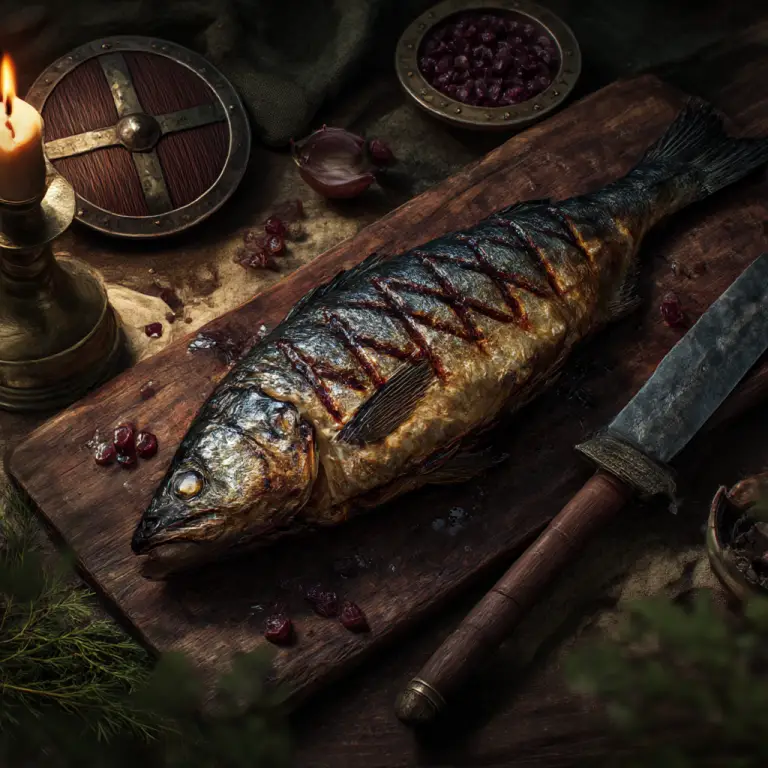Barley Porridge
Introduction:
Barley porridge was a staple of the Viking diet, eaten for breakfast or as a side dish. It provided energy and warmth during cold mornings and long journeys.
Ingredients:
- 200g pearl barley
- 1 litre water
- 250ml milk or soured milk
- Pinch of salt
- Honey or berries to serve
Instructions:
- Rinse barley under cold water.
- Place barley and water in a pot, bring to a boil.
- Reduce heat, simmer 40–50 minutes until tender.
- Stir in milk and salt, heat gently.
- Serve with honey or berries.
Historical Notes:
Barley was one of the most common grains in Viking Scandinavia. It was versatile and could be stored for long periods, making it ideal for everyday meals and travel.
Presentation Tips:
Serve in wooden bowls with a simple wooden spoon. Add a drizzle of honey or fresh berries to mimic Viking simplicity.
Roasted Root Vegetables
Introduction:
Root vegetables like carrots, turnips, and onions were easy to grow and store through winter. Roasting brought out natural sweetness and added flavour to Viking meals.
Ingredients:
- 2 carrots, peeled and cut into chunks
- 2 turnips, peeled and cut into chunks
- 1 onion, cut into wedges
- 2 tablespoons butter or animal fat
- Salt, pepper, and fresh herbs such as dill
Instructions:
- Preheat oven to 180°C.
- Toss vegetables with butter or fat, salt, pepper, and herbs.
- Roast 35–40 minutes until tender and golden, turning occasionally.
- Serve warm.
Historical Notes:
Root vegetables were a reliable winter food for Vikings. They could be stored in root cellars or fermented for longer preservation.
Presentation Tips:
Serve on a wooden platter with herbs sprinkled on top for a rustic, authentic look.
Hearty Meat Stew
Introduction:
Meat stews were common in Viking homes, combining protein with vegetables to create filling meals suitable for hard-working days.
Ingredients:
- 500g beef or mutton, cut into chunks
- 2 onions, chopped
- 2 carrots, chopped
- 2 turnips, chopped
- 1 litre water or stock
- Salt, pepper, and juniper berries
- Fresh herbs for garnish
Instructions:
- Brown meat in a heavy pot.
- Add vegetables, cook 5–7 minutes.
- Pour in water or stock, add salt, pepper, and juniper berries.
- Simmer 1–2 hours until meat is tender.
- Garnish with fresh herbs and serve hot.
Historical Notes:
Vikings preserved meat through salting, smoking, and drying. Stews were practical, nutritious, and could feed large groups.
Presentation Tips:
Serve directly from the pot to encourage communal dining. Wooden bowls enhance authenticity.
Smoked or Grilled Fish
Introduction:
Fish was essential to Viking diets, particularly in coastal or riverine communities. Smoking and grilling preserved the catch and added flavour.
Ingredients:
- 2 whole trout or salmon fillets
- Salt for curing
- Fresh herbs such as dill or juniper berries
- Lemon or preserved berries to serve
Instructions:
- Salt the fish for 20–30 minutes, rinse, and pat dry.
- Stuff or top with herbs.
- Grill over flame or roast 15–20 minutes until cooked.
- Serve with lemon or preserved berries.
Historical Notes:
Smoked fish was a key source of protein for Vikings and could be stored for weeks. Herbs and berries added flavour and nutritional value.
Presentation Tips:
Present whole fish on a wooden board with simple garnishes.
Skyr and Viking Desserts
Introduction:
Dairy products such as skyr or soured milk were important in Viking diets. Sweetened with honey or berries, they made simple and nutritious desserts.
Ingredients:
- 500ml whole milk
- 2 tablespoons plain yoghurt or starter culture
- Honey or fresh berries to serve
Instructions:
- Heat milk gently until warm.
- Stir in yoghurt, cover, and leave in a warm place 12–24 hours to thicken.
- Chill and serve with honey or berries.
Historical Notes:
Skyr was common across Scandinavia. It was a concentrated, protein-rich dairy product that could be eaten fresh or preserved.
Presentation Tips:
Serve in small rustic bowls. Top with fresh berries for colour and natural sweetness.
Viking Beverages
Introduction:
Vikings brewed ale from barley and fermented mead from honey. Drinks were an integral part of feasts and daily life.
Suggested Recipes:
- Simple Barley Ale: Brewed lightly for non-alcoholic versions or fermented traditionally for authentic flavour.
- Mead: Ferment honey with water and yeast for a sweet, aromatic drink.
Presentation Tips:
Serve in small wooden cups or drinking horns. Include herbal infusions for non-alcoholic options.
